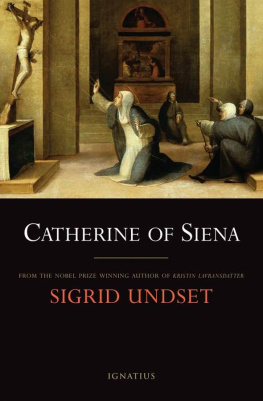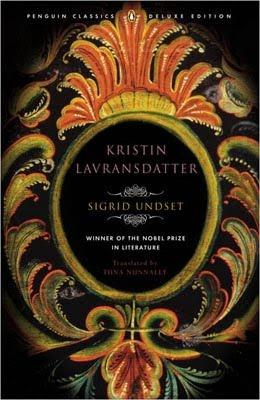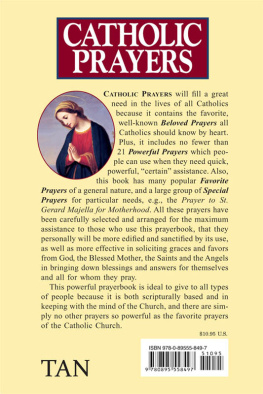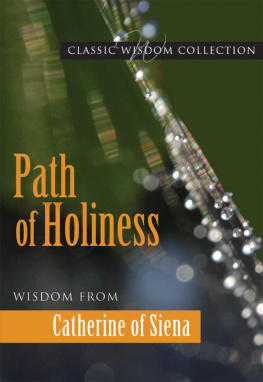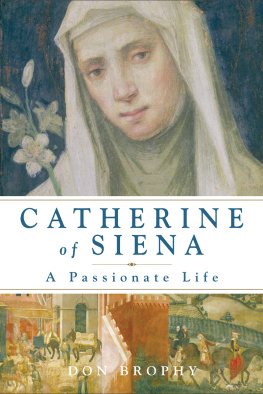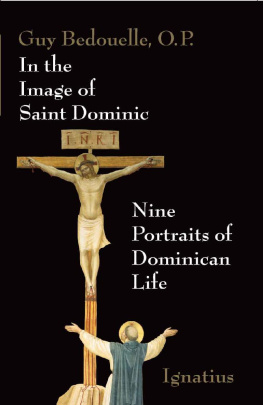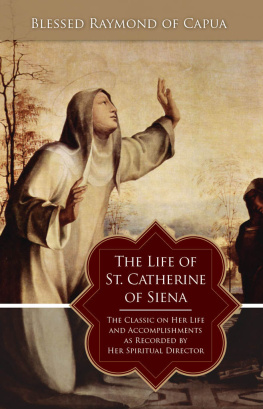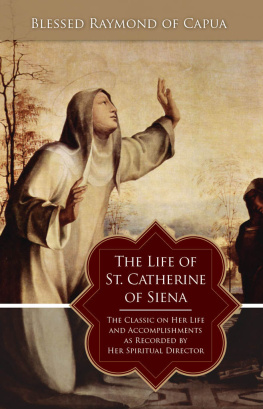CATHERINE OF SIENA
SIGRID UNDSET
CATHERINE OF SIENA
Translated by Kate Austin-Lund
IGNATIUS PRESS SAN FRANCISCO
Original edition:
1951 by H. Aschehoug and Company (W. Nygaard) AS
Oslo, Norway
Original English edition
1954 by Sheed and Ward, Inc., New York
All rights reserved
Published with ecclesiastical approval
Cover art: Saint Catherine of Siena Receiving the Stigmata
Domenico Beccafumi (1486-1551)
Coll. Moss Stanley, Riverdale-on-Hudson, New York
Scala / Art Resource, New York
Cover design by Roxanne Mei Lum
Published in 2009 by Ignatius Press, San Francisco
ISBN 978-1-58617-408-8
Library of Congress Control Number 2009923626
Printed in the United States of America
CONTENTS
I
IN THE CITY-STATES OF TUSCANY the citizens Popolani ; businessmen, master craftsmen and the professional class had already in the Middle Ages demanded and won the right to take part in the government of the republic side by side with the noblesthe Gentiluomini . In Siena they had obtained a third of the seats in the High Council as early as the twelfth century. In spite of the fact that the different parties and rival groups within the parties were in constant and often violent disagreement, and in spite of the frequent wars with Florence, Sienas neighbour and most powerful competitor, prosperity reigned within the city walls. The Sienese were rich and proud of their city, so they filled it with beautiful churches and public buildings. Masons, sculptors, painters and smiths who made the exquisite lattices and lamps, were seldom out of work. Life was like a brightly coloured tissue, where violence and vanity, greed and uninhibited desire for sensual pleasure, the longing for power, and ambition, were woven together in a multitude of patterns. But through the tissue ran silver threads of Christian charity, deep and genuine piety in the monasteries and among the good priests, among the brethren and sisters who had dedicated themselves to a life of helping their neighbours. The well-to-do and the common people had to the best of their ability provided for the sick, the poor and the lonely with unstinted generosity. In every class of the community there were good people who lived a quiet, modest and beautiful family life of purity and faith.
The family of Jacopo Benincasa was one of these. By trade he was a wool-dyer, and he worked with his elder sons and apprentices while his wife, Lapa di Puccio di Piagente, firmly and surely ruled the large household, although her life was an almost unbroken cycle of pregnancy and childbirthand almost half her children died while they were still quite small. It is uncertain how many of them grew up, but the names of thirteen children who lived are to be found on an old family tree of the Benincasas. Considering how terribly high the rate of infant mortality was at that time, Jacopo and Lapa were lucky in being able to bring up more than half the children they had brought into the world.
Jacopo Benincasa was a man of solid means when in 1346 he was able to rent a house in the Via dei Tintori, close to the Fonte Branda, one of the beautiful covered fountains which assured the town of a plentiful supply of fresh water. The old home of the Benincasas, which is still much as it was at that time, is, according to our ideas, a small house for such a big family. But in the Middle Ages people were not fussy about the question of housing, least of all the citizens of the fortified towns where people huddled together as best they could within the protection of the walls. Building space was expensive, and the city must have its open markets, churches and public buildings, which at any rate theoretically belonged to the entire population. The houses were crowded together in narrow, crooked streets. According to the ideas of that time the new home of the Benincasas was large and impressive.
Lapa had already had twenty-two children when she gave birth to twins, two little girls, on Annunciation Day, March 25, 1347. They were christened Catherine and Giovanna. Madonna Lapa could only nurse one of the twins herself, so little Giovanna was handed over to a nurse, while Catherine fed at her mothers breast. Never before had Monna Lapa been able to experience the joy of nursing her own childrena new pregnancy had always forced her to give her child over to another woman. But Catherine lived on her mothers milk until she was old enough to be weaned. It was all too natural that Lapa, who was already advanced in years, came to love this child with a demanding and well-meaning mother-love which later, when the child grew up, made the relationship between the good-hearted, simple Lapa and her young eagle of a daughter one long series of heart-rending misunderstandings. Lapa loved her immeasurably and understood her not at all.
Catherine remained the youngest and the darling of the whole family, for little Giovanna died in infancy, and a new Giovanna, born a few years later, soon followed her sister and namesake into the grave. Her parents consoled themselves with the firm belief that these small, innocent children had flown from their cradles straight into Paradisewhile Catherine, as Raimondo of Capua writes, using a slightly far-fetched pun on her name and the Latin word catena (a chain), had to work hard on earth before she could take a whole chain of saved souls with her to heaven.
When the Blessed Raimondo of Capua collected material for his biography of St. Catherine he got Madonna Lapa to tell him about the saints childhoodlong, long ago, for Lapa was by that time a widow of eighty. From Raimondos description one gets the impression that Lapa enjoyed telling everything that came into her head to such an understanding and responsive listener. She told of the old days when she was the active, busy mother in the middle of a flock of her own children, her nieces and nephews, grandchildren, friends and neighbours, and Catherine was the adored baby of a couple who were already elderly. Lapa described her husband Jacopo as a man of unparalleled goodness, piety and uprightness. Raimondo writes that Lapa herself had not a sign of the vices which one finds among people of our time; she was an innocent and simple soul, and completely without the ability to invent stories which were not true. But because she had the well-being of so many people on her shoulders, she could not be so unworldly and patient as her husband; or perhaps Jacopo was really almost too good for this world, so that his wife had to be even more practical than she already was, and on occasion she thought it her duty to utter a word or two of common sense to protect the interests of the family. For Jacopo never said a hard or untimely word however upset or badly treated he might be, and if others in the house gave way to their bad temper or used bitter or unkind words he always tried to talk them round: Now listen, for your own sake you must keep calm and not use such unseemly words. Once one of his townsmen tried to force him into paying a large sum of money which Jacopo did not owe him, and the honest dyer was hounded and persecuted till he was almost ruined by the slanderous talk of this man and his powerful friends. But in spite of everything Jacopo would not allow anyone to say a word against the man; Lapa did so, but her husband replied: Leave him in peace, you will see that God will show him his fault and protect us. And a short while after that it really happened, said Lapa.
Coarse words and dirty talk were unknown in the dyers home. His daughter Bonaventura, who was married to a young Sienese, Niccolo, was so much grieved when her husband and his friends engaged in loose talk and told doubtful jokes that she became physically ill and began to waste away. Her husband, who must really have been a well-meaning young man, was worried when he saw how thin and pale his bride was, and wanted to know what was wrong with her. Bonaventura replied seriously, In my fathers house I was not used to listening to such words as I must hear here every day. You can be sure that if such indecent talk continues in our house you will live to see me waste to death. Niccolo at once saw to it that all such bad habits which wounded his wifes feelings were stopped, and openly expressed his admiration for her chaste and modest ways, and the piety of his parents-in-law.
Next page
